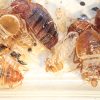Most of my career has focused on the integrated pest management and biology/ecology of pest insects. Agricultural pests caught my interest at first, but it was during my Master’s degree that I noted the importance of urban pests and that students majoring in urban entomology were receiving job offers before they graduated. During my undergraduate career at Rutgers University, I was involved with biological control and feeding rates of Colorado potato beetle and during my Master’s at Virginia Tech, I determined the seasonal presence of broccoli pests and their impact on yield. After my master’s, I joined the USDA-ARS as a technician in the Imported Fire Ant and Household Insects Unit in Gainesville, Florida and completed a PhD from the University of Florida. My work here revolved around the management of imported fire ants and the biology, behavior, spatial distribution and management of Pharaoh ants. In 1996,I started as an assistant professor and Extension urban entomology specialist in the University of Tennessee Institute of Agriculture’s Entomology and Plant Pathology Department. My programs at UT have focused on fire ant biology, biological control and other control methods; urban ant identification, distribution and management; bed bug management with an emphasis on early detection techniques; termite baiting and liquid applications; and integrated pest management in schools. Students in my lab are trained in research of urban pests, and have the opportunity to observe or experience the responsibilities of an Extension specialist including walk-in specimen identification, delivery of research-based information, and interactions with scientists, housing managers, school personnel, government agency personnel, pest management service providers, manufacturing industry leaders, and other stakeholders.

Research Focus
The Urban IPM Lab focuses on applied research of pests found in and around structures. Our current funded research involves developing effective and efficient building-wide bed bug detection techniques that will be implemented by multifamily housing managers. Bed bug management in low-income high-rises for the elderly and disabled is extremely demanding because of tenant activities, multi-unit construction and lack of funds. In 2013-2014, infestation rates were nearly unbelievable and averaged 33% in four of these local buildings. Highly unreliable resident reporting masks extensive infestations leaving managers with a false sense of management success. Thus we are addressing a critical need to simultaneously identify all bed bug infested apartments in a building to find unreported infestations and to ultimately limit spread. Not only do we develop the techniques, but through the Extension component of this project, we also demonstrate them in TN low-income housing thus effecting and documenting needed change. Previous bed bug related projects include determining relatedness of the bed bugs found within these structures and the effectiveness of vacuuming as a sole management practice.
We evaluate ant, termite and other urban pest management strategies which gives our students experience in conducting field trials in collaboration with industry as well as finding needed solutions to pest management problems. Through collaboration with Dr. Trout Fryxell, we use molecular tools to resolve questions of pest origin and relatedness.
Extension and outreach focus
Our urban pest management programs directed at the pest management professional (PMP), county Extension agents, Master Gardeners, and the public can potentially impact every one of the 6.7 million residents of Tennessee. Urban Integrated Pest Management (IPM) programs provide effective and economical pest management; protect the balance that exists between the pest, its natural enemies and the environment; reduce reliance on pesticides; and reduce and balance the risk of exposure to pesticides with the health risk associated with pests. They help protect the citizens of this state, improve their quality of life and sustain the pest management industry. Our programs cover household and structural pests for the public and professionals, and lawn and garden pests for the public. Pest identification, a key step to managing pests, is performed via living and preserved specimens and digital images (e-mail, Distance Diagnostics). IPM information is also disseminated through workshops, training sessions and other presentations, publications (printed and electronic), mass media (newspaper, radio, newsletters, TV), social media, phone calls, e-mails, office visits and other meetings.
Current funded Extension projects include an integrated pest management demonstration in two school systems with the ultimate goal of improving the health of children/staff and the learning environment by limiting exposure to pests and pesticides. We expect target audiences to increase their knowledge of Integrated Pest Management (IPM), increase use of IPM tactics, reduce use of higher risk pesticides, increase adoption of lower risk pesticides, reduce/eliminate pest problems, and increase staff training in implementing IPM tactics.
Teaching focus
As an Extension specialist in urban entomology I direct the majority of my educational efforts toward pest management (PMPs) and other professionals, with the remainder of my efforts directed to Extension agents (Agricultural, Family & Consumer Sciences and 4H), Master Gardeners, graduate and undergraduate students and the general public. Although levels of expertise and education vary among groups of PMPs and other students, Extension programs are provided to people of all educational backgrounds. Extension can be thought of as the hand that reaches out from the university to serve the state’s diverse population, regardless of education level, and aims to improve the quality of life by providing research-based information to solve today’s problems, in my case, pest problems.
Because the level of expertise and education of my “students” varies greatly, a variety of innovative teaching methods, including presentations, problem-solving scenarios and other group-processing techniques, case studies and questioning are used to deliver state-wide integrated pest management educational programs.
A wise friend of mine said most of the people in the pest management industry are involved because they are problem solvers. It’s not the pay or the benefits that keeps them in this industry, but the reward from solving a person’s or company’s pest problem. That is why I incorporated problem solving scenarios into my PMP presentations. Audiences are divided into groups to separately brainstorm and then come together to discuss solutions. This promotes problem-solving strategies and just as importantly, helps unify a competitive industry by allowing friendships and networks to form.
Courses
Guest lectures are provided in:
EPP425/525 Medical and Veterinary Entomology (bed bugs/cockroaches),
PUBH 420 Environmental Public Health (bed bugs)
EPP630 Advanced Integrated Pest and Pathogen Management (up to 3 lectures per course- school IPM, bed bugs, fire ants)
EPP 201 Impact of Insect and Plant Diseases on Human Society (fire ants or bed bugs)
Events
Give to the Urban Entomology Special Interest Gift Fund
Karen Vail
Professor
office (865) 974-8800
mobile (865) 567-0617
fax (865) 974-8868
kvail@utk.edu
EDUCATION
B.S., Plant Science, Option in IPM, Rutgers University
M.S., Entomology, Virginia Tech
Ph.D., Entomology, University of Florida
WEBSITES
School IPM
Fire ants in Tennessee
Bed bugs in Tennessee
Urban IPM in Tennessee Facebook page
Urban Integrated Pest Management
PROFESSIONAL APPOINTMENT
100% Extension
GRADUATE PROGRAM CONCENTRATIONS
Sustainable Disease and Integrated Pest Management Systems
AREAS OF EXPERTISE
Management of household/structural pests with a current emphasis on odorous house ants and bed bugs

RESEARCH QUESTIONS IN OUR LABORATORY

CURRENT LAB MEMBERS
SELECTED PUBLICATIONS
Butler, R., Chandler, J., Vail, K., Holderman, C., Trout Fryxell, R. (2021). Spray and Pour-On Acaricides Killed Tennessee (United States) Field-Collected Haemaphysalis longicornis Nymphs (Acari: Ixodidae) in Laboratory Bioassays, Journal of Medical Entomology, Volume 58, Issue 6, Pages 2514–2518. https://doi.org/10.1093/jme/tjab115
Black, M. K., Chandler, J. G., Trout Fryxell, R. T., & Vail, K. M. (2021). The Common Bed Bug (Hemiptera: Cimicidae) Does Not Commonly Use Canines and Felines as a Host in Low-Income, High-Rise Apartments. Journal of Medical Entomology, 58(6), 2040–2046. https://doi.org/10.1093/jme/tjab070








